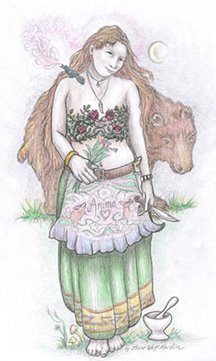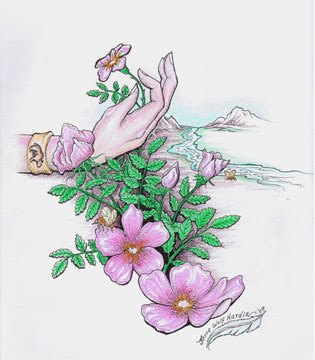
Here's a lovely recipe Loba and I came up with the other night, in the spirit of our recent Faery Tale inspired meals. Though we're not quite done editing Loba's last cookbook, The Enchanted Pantry, we seem to be well on the way to collecting recipes for a new wild-foods based cookbook. I'll be posting recipes from both books regularly here. To make the Monarda Pesto mentioned below, you can use any good pesto recipe and subsitute fresh Monarda leaves for the Basil, along with a bit of curry powder, and don't forget the Piñon Pine Nuts! This is a great early Spring dish when the evenings are still cool but the greens are popping up everywhere.
Enchanted Forest Stinging Nettle Stew
5 Chicken pieces (though Turkey is lovely too)
1 large Onion, sauteed
10-15 whole Shitake Mushrooms (fresh or dried)
3 TB fresh Ginger sauteed in butter
1 C Tomato sauce or salsa
big bunch of fresh Stinging Nettles
2-3 TB Olive Oil
Salt and Pepper to taste
Roasted Garlic to taste
Monarda Pesto to taste
Brown chicken, simmer mushrooms and chicken together for two hours. Remove mushrooms and chicken, cut mushrooms into slices, de-bone chicken and add both mushrooms and chicken meat back to broth. Add all remaining ingredients except pesto, simmer for 15-20 minutes. Optionally, serve with chunks of goat cheese or cheese covered toast placed directly in the stew. Garnish with a generous spoonful of Monarda Pesto.
Sunday, April 22, 2007
Enchanted Forest Stinging Nettle Stew
Posted by
Oakmoss Changeling
at
9:56 AM
3
comments
![]()
Labels: From the Hearth
Saturday, April 21, 2007
Re-Connecting with Forgotten Friends
 I’ve noticed a recent trend towards herbal exploration and re-discovery. Not completely content to defer to America’s most marketed herbs list, we’ve been digging through old books, sifting through the older people’s memories and tasting, testing and playing with every new plant we come across. This isn’t because we don’t already have wonderfully effective allies to work with, but because each bioregion has its own prolific plant communities that are readily available, free of charge and best of all, intimately connected to us through the air we breathe, the earth we grow from and the rain that quenches our thirst.
I’ve noticed a recent trend towards herbal exploration and re-discovery. Not completely content to defer to America’s most marketed herbs list, we’ve been digging through old books, sifting through the older people’s memories and tasting, testing and playing with every new plant we come across. This isn’t because we don’t already have wonderfully effective allies to work with, but because each bioregion has its own prolific plant communities that are readily available, free of charge and best of all, intimately connected to us through the air we breathe, the earth we grow from and the rain that quenches our thirst.
New herbs have been sifting back into common consciousness through the committed work of many herbalists, and Matt Wood was one of the first to really open my eyes to new ways of working with unusual and non-typical plants. His innovative use of plants like Teasel helped me to be brave enough to go outside and try a taste of various leafy friends who had been calling to me but I was afraid to experiment with (“surely if it was medicinal, it would be in all the plant books, right?”). Another great inspiration has been Jim McDonald’s excellent work with Purple Loosestrife, Calamus, Mullein and Aster.
So this year, as I continue to build on the knowledge of the foundation herbs I best know, I’m focusing on getting to know a few off-brand herbs, like Sweet Clover, Dragonhead, Fireweed, Alder, Speedwell and Wild Peony. I’m looking forward to expanding my knowledge about local Gila plants, and I’m especially excited to meet local tonic herbs. Expect to see posts on many of these new friends this growing season.
There’s a myriad of methods to get to know the plants better and I’ve listed some in my previous posts on intimacy and specific medicines. Here I want to mention a few ways to form an introduction to an unfamiliar plant.
1) Be open - listen when a new plant calls to you, even if you don’t recognize it or have previously heard/read it referred to as useless or insignificant.
2) Participate - Once you’ve identified the plant and know the plant is not toxic, taste it and record your impressions. I like to use an energetic basis and include hot or cold, dry or moist. I also note how the plant affects my pulse, state of mind, mood, etc. This is, of course, quite subjective, but repeated experiences will tend to give you an idea of the basics. The most important thing is to let yourself experience the energy of the plant and to participate in the specific dance of that herb. This is a great thing to do with plants you already know too!
3) Research - Don’t limit your herb reading to glossy covered books with the newest studies and constituent lists, remember to read the herbal classics by the likes of William Cook, Culpeper, Hildegard von Bingem and others. These books are oft ignored treasure troves, and many of these out of print books can be found of the web sites of Henriette Kress, Michael Moore and Paul Bergner. Purposely search out books containing information on less known plants, besides the old classics, good ethnobotanical texts and bioregional herbals are great sources of nearly forgotten knowledge.
4) Ask around - Ask the old people in your area what they know about local weeds, start up a conversation with anyone you see harvesting wild plants, you never know what gems and amazing stories they might hold. And don’t forget to ask your own family members, you might be surprised at the healing tidbits Great Aunt Mary has hidden up her sleeve ;)
5) Listen - Don’t just constantly regurgitate what you already know, open your ears around other plant people, even people you consider to be less experienced or knowledgeable then yourself. I’m learned amazing things about plants from children who just thought to try something spontaneously.
6) Share - Making your valuable experience available guarantees that the knowledge will be shared and hopefully help others as well as generate new experiences and information. A huge part of herbalism is still within the oral tradition and the only way to keep that from being lost is to share it with others.
It can be tempting to be discouraged by the seeming lack of information on a certain plant, and you may feel like sticking with more familiar herbs in order to remain in known, safe territory. It takes courage to experiment, experience and then put yourself on the line as possibly crazy when telling others about a strange new green friend. But persevere, and you’ll find a whole new world of exciting possibilities just beyond your back door!
Posted by
Oakmoss Changeling
at
6:56 PM
0
comments
![]()
Labels: Medicine Woman Materia Medica
Saturday, April 14, 2007
Rain, Wildflowers and Medicine
It's been raining again! A surprise storm hit us the night before last and dumped a significant amount of snow and rain on us. And what a pleasant surprise it was, We in NM have been bracing ourselves against another fairly dry Spring. This new moisture will provide with an extra beautiful show of wildflowers and herbs, and there's talk of yet more rain later this weekend. Many plants have grown visibly in the last 24 hours, sucking down the moisture and shooting skyward. An amazing mist rose off the river early this morning, cloaking the canyon walls in a faery fog while sun rose into the lapiz blue sky above.
A few days ago, my little daughter and I took a good long walk up the large arroyo to find Spring beautifully underway with Wild Grapes already leafing out and the intense scent of Wild Olives, Redroot and Wax Currants filling the air so thickly it made us almost dizzy. Up over sparkling rocks and stone wall waterfalls we climbed, high up into the lush crevice between mountain ridges. We harvested a bagful of Monarda, Dragonhead, Rose leaves, Mountain Valerian, Oregon Grape Root, Western Mugwort and Redroot flowers...
Once home, we proceeded to lay many plants out to dry and to chop up the others for tincture, vinegar and oil. When all was said and done, we had many new quarts of nourishment and medicine.
It's also prime Stinging Nettle season, our patches are vibrant and luxurious this year, providing with almost daily mineral rich meals, and soon we'll be harvesting huge batches to dry for infusions and soups, and some for vinegar and tincture. I'm especially looking forward to working with Nettle seeds this year!
A great benefit of these lovely Spring rains, is how wonderful this year's Medicine Woman's Wild Plant Workshop will be! Though the workshop is always great fun and filled with many plant allies, this year will be an extra treat. To take advantage of all the new growth and unusual species popping up, the workshop will filled with many extended plants walks into the varied environs that make up this diverse riparian canyon that includes montane, foothill, desert and riparian species. We have a few spaces left in the workshop, so be sure to let me know if you're interested!
I've been deepening my relationship with Rose quite a bit lately through some amazing experiences, and find myself in the midst of a very long essay on her beauty and power. I hope to have this finished in the next week, and share it here.
Posted by
Oakmoss Changeling
at
12:31 PM
3
comments
![]()
Labels: Green Tidbits
Tuesday, April 3, 2007
Alder: Tree of Transformation & Healing

You remember that toothache I talked about a few posts ago? Well, despite repeated attempts with various herbs including Oregon Grape Root, Usnea, Redroot, Balsamroot and Echinacea, I was unable to shake the infection that seemed to just roam throughout my mouth. The herbs managed to keep the pain and swelling in check, but never completely resolved the problem. Strange, as I've treated other toothaches and infections with these same formulas many times before. Nevertheless, it provided a valuable opportunity for exploring new herbs for infection and pain.
With no dentist nearby, I sat down to puzzle about what other local herbs might work. I do have a supply of Goldenseal and few other herbs that were applicable to the situation but I was more interested in trying a local herb that I hadn't yet used in this capacity. Alder, a tree who's name means "Healing Woman" by some indigenous tribes, came to mind as a strong antibacterial alterative with an affinity for the lymph system. Since swollen lymph nodes had been part of the toothache's symptoms I figured this made the Alder especially appropriate. I had a tincture I'd made early this Winter of dried bark, catkins and cones (fresh bark can be emetic). While Alder is often called another simple astringent, some herbalists (including Idaho herbalist Darcy Williamson) has found it to be effective against Staph, Pseudomonas and other bacteria. It's also a great allergy preventative, skin healer, general cooling alterative and lymphatic. And it IS astringent, though not as much as say, Dock or Alum root.
So I gave it a shot, taking two dropperfulls 3-4 times a day. And I'll be damned if it didn't decrease the small but steady ache to nothing in three hours, all swelling gone in a day and gum sensitivity disappeared in two days. Seeing how Alder is such a common riparian tree (a far more common plant than Oregon Grape Root) in my canyon home I'm very excited to utilize it more often for various kinds of infection.
It also seems to reduce headache pain, and definitely has a strong effect on the GI system. It tends to be quite cooling and drying and it's emphasis appears to be on moving and balancing fluids through the blood, lymph and immune system. I've found it to work quite well with Sage. Dr. William Cook said:
The bark is the medicinal part, and is readily acted on by water. It is mildly astringent, and slowly stimulating to the cutaneous and renal secretions. It is good as an alterant in the treatment of scrofula, scrofulous and cachectic ulcers. The profession have by no means given to the article the attention it deserves; but have sent abroad for sarsaparilla, when the despised alder at their door is probably quite as valuable, especially when combined with suitable stimulants. A strong decoction of the article is a useful wash in scrofulous and venereal ulcers, and in chronic ophthalmia; and the same has been used as a popular drink in sub-acute diarrhea, and will be found a good injection in leucorrhea..

I've also used the leaves and bark infused into oil with very nice results as a general salve, especially when used for skin disorders like contact dermatitis, eczema and psoriasis as well mouth sores and ulcers. Nice combined with Rose, Sage or Elderflower/leaf.
A member of the Birch family, our Canyon Alder (Alnus oblongifolia) has beautiful silver bark with an underlying skin of blood red revealed by the scratching of bear claws and elk antlers (who are both quite fond of this tree). It lives right on the river bank with its roots dangling in a silver web in and just above the water. This tree has always spoken to me of the balance of fire and water, of rebirth and change. My partner Jesse Wolf Hardin wrote eloquently of Alder's mythological and spiritual aspects in his upcoming novel, The Medicine Bear:
The alder would have felt special to Omen even if she had never learned any of its story, or learned to read by studying its myths. She loved that it had been long known as the King Of The Fairies, that the faces of the Sacred Kings during the Midsummer rituals were painted with the red dye of its inner bark. That the fairies were said to use the Alder catkins to dye their clothes, thereby making themselves invisible to human eyes. That while its wood burned slow, it nevertheless made the best and hottest charcoal, and had once been the choice of medieval warriors for forging their magically imbued swords. That woodsmen would sometimes strike the silvery barked trees with an axe, and then upon seeing the bright red flesh beneath, be reminded of blood and made too sympathetic to continue an assault. For these reasons and more, the alder was considered to embody the power of fire. And because of the way it turned water into steam, it was called the Tree Of Resurrection by Homer. The alder was the botanical Phoenix, Omen had decided... the leaf-feathered firebird of rebirth.
This is a plant with many facets and faces, and one too little explored in modern American herbalism. If anyone else uses Alder medicinally or otherwise I'd love to hear about your experiences. Expect more posts on this remarkable tree in the future.
Resources:
Healing Plants of the Rocky Mountains by Darcy Williamson
Medicinal Plants of the Pacific West by Michael Moore
Edible and Medicinal Plants of the Rocky Mountains and Neighboring Territories by Terry Willard
Sacred Plant Medicine by Stephen Buhner
Posted by
Oakmoss Changeling
at
2:02 PM
6
comments
![]()
Labels: Medicine Woman Materia Medica, Therapeutics and Nutrition
All writings & posts (c)2007 Kiva Rose
All artwork & photographs (c) 2007 Jesse Wolf Hardin











